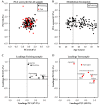The Aging Process: A Metabolomics Perspective
- PMID: 36557788
- PMCID: PMC9785117
- DOI: 10.3390/molecules27248656
The Aging Process: A Metabolomics Perspective
Abstract
Aging process is characterized by a progressive decline of several organic, physiological, and metabolic functions whose precise mechanism remains unclear. Metabolomics allows the identification of several metabolites and may contribute to clarifying the aging-regulated metabolic pathways. We aimed to investigate aging-related serum metabolic changes using a metabolomics approach. Fasting blood serum samples from 138 apparently healthy individuals (20−70 years old, 56% men) were analyzed by Proton Nuclear Magnetic Resonance spectroscopy (1H NMR) and Liquid Chromatography-High-Resolution Mass Spectrometry (LC-HRMS), and for clinical markers. Associations of the metabolic profile with age were explored via Correlations (r); Metabolite Set Enrichment Analysis; Multiple Linear Regression; and Aging Metabolism Breakpoint. The age increase was positively correlated (0.212 ≤ r ≤ 0.370, p < 0.05) with the clinical markers (total cholesterol, HDL, LDL, VLDL, triacylglyceride, and glucose levels); negatively correlated (−0.285 ≤ r ≤ −0.214, p < 0.05) with tryptophan, 3-hydroxyisobutyrate, asparagine, isoleucine, leucine, and valine levels, but positively (0.237 ≤ r ≤ 0.269, p < 0.05) with aspartate and ornithine levels. These metabolites resulted in three enriched pathways: valine, leucine, and isoleucine degradation, urea cycle, and ammonia recycling. Additionally, serum metabolic levels of 3-hydroxyisobutyrate, isoleucine, aspartate, and ornithine explained 27.3% of the age variation, with the aging metabolism breakpoint occurring after the third decade of life. These results indicate that the aging process is potentially associated with reduced serum branched-chain amino acid levels (especially after the third decade of life) and progressively increased levels of serum metabolites indicative of the urea cycle.
Keywords: liquid chromatography-high-resolution mass spectrometry; metabolism; metabolome; nuclear magnetic resonance.
Conflict of interest statement
The authors declare no conflict of interest.
Figures



References
MeSH terms
Substances
Grants and funding
LinkOut - more resources
Full Text Sources

